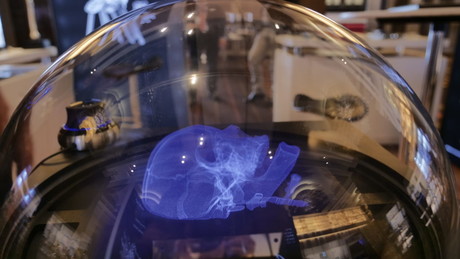Volumetrics company brings holograms closer to reality

South Australian volumetrics business Voxon Photonics, creator of 3D volumetric display technology inspired by the holograms of classic science-fiction, is taking the world by storm, having recently won the Consumer Markets category at the National Australian Information Industry Association (AIIA) iAwards — an awards program for technology innovation.
Founded by CTO Gavin Smith and CEO Will Tamblyn, the company was recognised for its Voxon VX1 3D volumetrics unit, which seeks to bring digital content to life with no need for glasses, goggles or headgear. According to Smith, the technology is the only commercialised, market-ready advanced 3D volumetrics display product available.
Using the principle of ‘persistence of vision’, VX1 projects images into a space that has an x, y and z resolution that can be viewed from any angle without the need of a headset or 3D glasses. Persistence of vision is the optical illusion that occurs when multiple discrete images blend into one due to the human eye’s inability to track high-speed light.
“Our hardware–software platform projects 4000 cross-sectional images onto a very high-speed physically moving screen, so we have a high-speed screen that physically resonates up and down and projects cross-sectional images,” said Smith.
The physical volume of data that is rendered in each VX1 unit is 18 x 18 x 8 cm, the same size as the box that contains the projected light with a display resolution of 1000 x 1000 x 200. This projects 30 volumes of light every second at an average of around one million points of light for a single frame.
“The timing of the display is such that each image hits the screen within one four-thousandth of a second, and through persistence of vision you see all the slices together — which creates a truly three-dimensional volumetric image which has the same physical attributes as a physical object,” Smith explained.
Voxon Photonics has now sold its 3D volumetric display in more than 15 countries and is getting noticed by leading technology organisations in a multitude of markets such as education, medical, gaming, engineering visualisation, communications, automotive and marketing. The company is also taking the technology to major events, having recently demonstrated its two-way holographic videoconferencing system over a 5G network at the Mobile World Congress Americas 2018 in Los Angeles.
The event saw the VX1 unit being used to simulate a futuristic doctor-to-patient communication scenario with 3D hologram displays being shared across two spaces in real time, over an ultrahigh-speed mobile connection supplied by international telecommunications company Verizon. Mobile services corporation Ericsson also assisted with the development of the project, which took a total of three months to complete.
“This project was really the catalyst for making a face-to-face communication display,” said Smith.
Verizon’s and Ericsson’s stands at the three-day event featured a two-way, holographic video communication system, which captured a user’s face in three dimensions using an Intel RealSense Depth camera and livestreamed the data onto Voxon’s 3D volumetric units. A hologram projection of medical imaging data sat next to each user as a reference for them to discuss.
“This is the first time we’ve used the software in a real-life scenario where we’ve created a shared social experience over a network, so you’re both viewing the same medical data in real time and sharing the same physical experience in two different locations,” Smith said.
“It’s [also] the first time we’ve been able to do it over a wireless connection as the bandwidth requirements are so high. We’re sending two 100-megabit streams over a wireless network; in this case it was Verizon’s 5G live mobile connection.”

According to Smith, the project highlighted the practicality of the technology for uses across a range of industries with demand for 3D volumetrics displays.
“It’s early days for videoconferencing, but from the feedback we’ve had, we’ve got 10 or 20 potential use cases for the technology, whether it’s communication, experiential advertising, education or simulation,” he said.
And the company is still on the lookout for new market opportunities, with Smith stating, “We’re building strong relationships with multiple partners across multiple industries and [are] listening to the user requirements and directing all our company’s focus to proof-of-concept projects with companies.
“What we’re looking for is corporate partners to evaluate the technology for their own uses or to just strengthen our own beliefs in some of the markets we believe it will be strong in, such as education and 3D gaming.”
Spinning, twisted light could power next-generation electronics
Researchers have created an organic semiconductor that forces electrons to move in a spiral...
Improving the way flash memory is made
Researchers are developing the ideal manufacturing process for a type of digital memory known as...
Optical memory unit boosts processing speed
Researchers have developed a fast, versatile volatile photonic memory that could enhance AI,...





